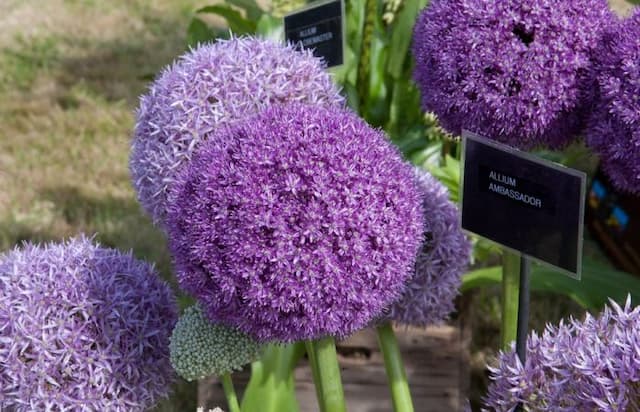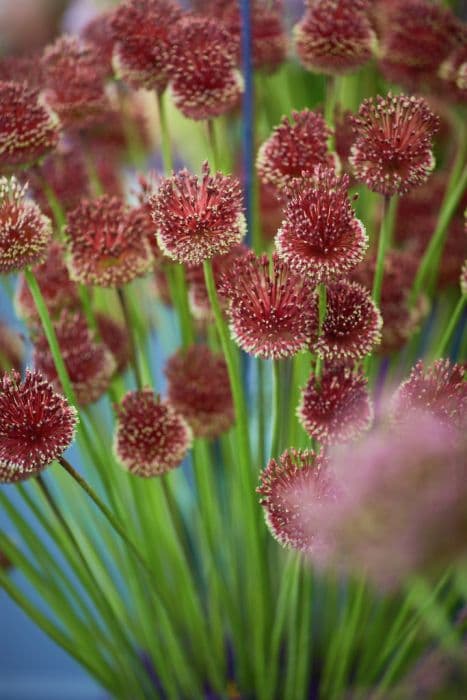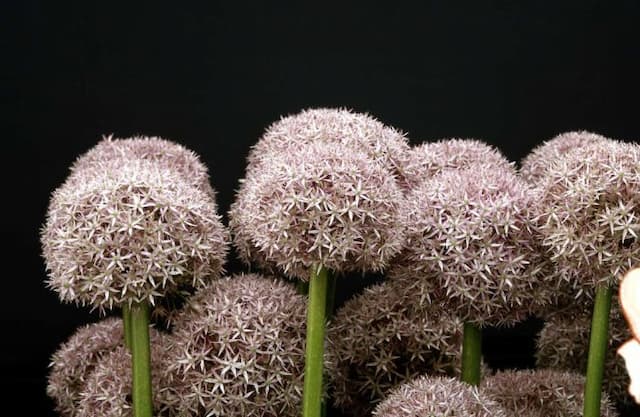Leek Allium porrum (Swiss Giant Group) 'Jolant'

ABOUT
The Allium porrum, commonly known as leek, particularly the 'Jolant' variety from the Swiss Giant Group, is a plant known for its striking appearance. With a long white base that transitions to a bright green as you look upwards, the leek bears a resemblance to large green onions. The base, often referred to as the stem or shaft, is cylindrical with a slightly bulging shape, gradually merging with the root system at the bottom. The green portion divides into many flat, overlapping leaves that grow upward and outward in a fan-like fashion. The leaves are typically a vibrant, dark green color and have a somewhat thick, leathery texture, showing a resilience to the elements. Similarly to the other members of the onion family, these leaves have an indented groove running their length, which gives them a folded or creased appearance. The transition area from the white base to the green leaves is generally subtle, characterized by a gentle gradient of color, which provides a noticeable contrast against the vivid green of the foliage. The visual qualities of the leek, especially from the 'Jolant' variety, lend this plant a unique aesthetic appeal that can be recognized in gardens and kitchens alike. The leeks don't typically bear visible flowers, as they are usually harvested before they reach the flowering stage for culinary use. However, if left to flower, Allium porrum can produce a spherical flower cluster on top of a sturdy, erect stalk that extends above the rest of the plant, featuring numerous small, usually purple or pink flowers.
About this plant
 Names
NamesFamily
Amaryllidaceae
Synonyms
Leek, Great Britain Leek, Swiss Giant Leek
Common names
Allium porrum
 Toxicity
ToxicityTo humans
Leek 'Jolant' is not considered toxic to humans and is commonly grown for culinary use. As with any food, some individuals may have sensitivities or allergies to leeks, but they are not poisonous.
To pets
Leeks, including the Leek 'Jolant', are toxic to pets such as dogs and cats. Leeks are members of the Allium family, and they contain organosulfoxides that can cause oxidative damage to red blood cells leading to hemolysis. Symptoms of poisoning in pets may include vomiting, diarrhea, abdominal pain, loss of appetite, and in more severe cases, red urine, pale gums, increased heart rate, weakness, and collapse. If a pet ingests leeks, prompt veterinary attention is recommended.
 Characteristics
CharacteristicsLife cycle
Biennials
Foliage type
Deciduous
Color of leaves
Green
Height
1-3 feet (30-90 cm)
Spread
1-2 feet (30-60 cm)
Plant type
Herb
Hardiness zones
5
Native area
Eurasia
Benefits
 General Benefits
General Benefits- Edible: The leek provides flavorful leaves and stems that are commonly used in cooking, especially in soups and stews.
- Nutritious: Leeks are a good source of vitamins A, C, and K, as well as minerals like iron and manganese.
- Culinary Versatility: Can be used in a wide range of dishes, from raw in salads to cooked in pies and quiches.
- Easy to Grow: Leeks are hardy and can be grown in a variety of climates, making them suitable for many gardens.
- Extended Harvest: They can be harvested late into the fall and even winter in some climates, providing a prolonged yield.
- Companion Planting: Leeks can benefit other plants by repelling pests like carrot flies when planted in close proximity.
- Ornamental Value: With their tall, elegant stems and green foliage, they can add aesthetic value to a vegetable garden.
- Soil Improvement: Leeks can help break up heavy soils with their deep root systems, improving soil structure over time.
- Minimal Pest Issues: They are relatively resistant to pests, reducing the need for chemical pesticides.
- Carbon Footprint: Growing your own leeks can reduce your carbon footprint compared to buying imported leeks from the store.
 Medical Properties
Medical Properties- Antioxidant: Leeks, including Allium porrum, contain antioxidants which can neutralize free radicals and may reduce oxidative stress.
- Cardiovascular support: They may support heart health due to their content of flavonoids and polyphenols.
- Digestive health: Leeks are a source of dietary fiber, which can aid in digestion and help maintain a healthy gut.
- Anti-inflammatory: The various phytochemicals present in leeks might possess anti-inflammatory properties.
- Antimicrobial: Certain compounds found in leeks have shown antimicrobial activity in studies, but this is not directly linked to treating infectious diseases in humans.
 Air-purifying Qualities
Air-purifying QualitiesThis plant is not specifically known for air purifying qualities.
 Other Uses
Other Uses- Leek plant fibers can be used in textile production, where they are processed into a form of plant-based fabric suitable for crafting various types of garments.
- When dried and pulverized, leek foliage can serve as a natural dye for coloring fabrics and yarns in shades of green.
- Leek blooms are an attractive addition to floral arrangements, providing a unique and delicate touch to bouquets and centerpieces.
- Due to its sturdy structure, leek stalks can be repurposed into biodegradable plant stakes for supporting other small plants in the garden.
- The vegetable can be composted after use to return nutrients to the soil, promoting a healthier garden ecosystem.
- Creative cooks can use leek leaves as a natural wrapping for cooking, similar to grape leaves in dolmas or corn husks in tamales.
- Leek seeds are a food source for birds; dried leek heads can be set out in the winter to attract feathered visitors to the garden.
- Leek's subtle flavor can be infused into oils or vinegars, adding a nuanced taste to dressings and marinades without overpowering other ingredients.
- When hollowed out, the sturdy layers of a leek can serve as a biodegradable piping bag for culinary decoration.
- In eco-crafting, dried leek layers can be used to create rustic decorative features, such as small wreaths or garlands for a natural aesthetic.
Interesting Facts
 Feng Shui
Feng ShuiThe leek is not used in Feng Shui practice.
 Zodiac Sign Compitability
Zodiac Sign CompitabilityThe leek is not used in astrology practice.
 Plant Symbolism
Plant Symbolism- Perseverance - The sturdiness and hardy nature of leeks symbolize the ability to withstand adverse conditions.
- Growth - As a plant that grows upright, leeks signify positive growth, either spiritually or physically.
- Purity - Leeks are often considered a symbol of purity and cleanliness due to their association with traditional cleansing diets.
- Protection - In folk traditions, leeks are believed to offer protection against evil spirits.
 Water
WaterLeeks, such as the 'Jolant' variety, prefer consistent moisture to ensure steady growth. Water them deeply about once a week, providing 1 to 1.5 inches of water each time, depending on weather conditions. In periods of drought or extreme heat, monitor the soil moisture level more closely and water as needed to prevent the soil from drying out. During cooler weather or rainy spells, you can reduce the watering frequency. Over-watering can lead to issues such as root rot, so it's crucial to allow the soil to dry out slightly between waterings.
 Light
LightLeeks like 'Jolant' thrive in full sunlight, meaning they need at least 6 to 8 hours of direct sun daily. This plant grows best when it receives unfiltered sunlight throughout the day. However, in extremely hot climates, leeks can benefit from light afternoon shade to protect them from intense heat.
 Temperature
TemperatureThe 'Jolant' leek variety is tolerant of a wide range of temperatures but grows best in cooler conditions. They can survive minimum temperatures down to around 20 degrees Fahrenheit, essential for germination and early growth stages. The ideal growing temperature range for leeks is between 55 and 75 degrees Fahrenheit.
 Pruning
PruningPruning 'Jolant' leeks generally refers to trimming the roots and cutting back the leaves when transplanting to promote better growth. Additionally, remove any yellowed or damaged leaves throughout the growing season to maintain plant health and appearance. Pruning is typically done at transplant and not regularly required after that, except for periodic cleanup.
 Cleaning
CleaningAs needed
 Soil
SoilLeeks, such as the 'Jolant' variety, thrive in well-draining soil with a pH between 6.0 and 7.5. The best soil mix for leeks is a blend of garden soil, compost, and aged manure to provide ample nutrients. Perlite or sand can be added to enhance drainage.
 Repotting
RepottingLeeks generally don't require repotting as they are biennial and are usually harvested within the same year they are planted. However, if starting indoors, transplant the leeks into the garden when they are pencil-thick.
 Humidity & Misting
Humidity & MistingLeeks like 'Jolant' prefer moderate humidity levels but are quite adaptable. They don't have specific humidity requirements, as they are more concerned with soil moisture than air humidity.
 Suitable locations
Suitable locationsIndoor
Provide leeks with deep pots, ample sunlight, and rich soil.
Outdoor
Plant in sun, fertile soil, provide space, and keep soil moist.
Hardiness zone
5-10 USDA.
 Life cycle
Life cycleAllium porrum 'Jolant', more commonly known as leek, begins its life cycle when seeds are sown, typically in early spring. Seedlings emerge after germination, showing their initial leaves (cotyledons), and soon develop true leaves as they mature into young plants. As leeks grow, they put energy into elongating their stems, forming thick, white pseudo-stems through accumulated leaf sheaths, a process known as blanching which is enhanced by earthing up soil around them. During the growing season, leeks require consistent watering and weeding for optimal growth. After reaching maturity in late summer or fall, leeks are ready for harvest when their pseudo-stems have developed enough girth and length. If left unharvested, leeks can eventually flower in their second year, setting seed for future propagation before completing their biennial life cycle.
 Propogation
PropogationPropogation time
Spring
The Allium porrum, more commonly known as the leek, particularly the 'Jolant' variety from the Swiss Giant Group, is typically propagated through seed. The best time to sow leek seeds is in late winter or early spring, approximately 8-10 weeks before the last expected frost. To propagate leeks by seed, fill a seed tray or pots with a sterile seed starting mix and sprinkle the small seeds on top, lightly covering them with a thin layer of soil. Keep the soil moist but not waterlogged and maintain a temperature around 70°F (21°C). Seedlings generally emerge within 10 to 14 days. Once the seedlings have grown several inches tall and have at least two sets of true leaves, they can be transplanted to their final growing position in well-drained soil with plenty of sunlight.









